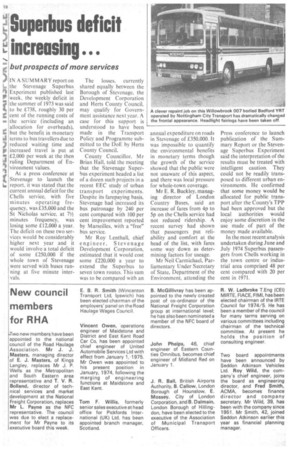Superbus deficit increasing
Page 20

If you've noticed an error in this article please click here to report it so we can fix it.
but prospects of more services
IN A SUMMARY report on the Stevenage Superbus Experiment published last week, the weekly deficit in the summer of 1973 was said to he 038, roughly 30 per cent of the running costs of the service (including an allocation for overheads), but the benefit in monetary terms to bus travellers due to reduced waiting time and increased travel is put at £2,000 per week at the then ruling Department of Environment values.
At a press conference at Stevenage to launch the report, it was stated that the current animal deficit for the Chells service, with five minutes operating frequency, was 05,000 and the St Nicholas service, at 71/2 minutes frequency, was losing some £12,000 a year. The deficit on these two services would be considerably higher next year and it would involve a total deficit of some £250,000 if the whole town of Stevenage were served with buses running at five minute intervals. The losses, currently shared equally between the Borough of Stevenage, the Development Corporation and Herts County Council. may qualify for Government assistance next year. A case for this support is understood to have been made in the Transport Policy and Programme submitted to the DoE by Herts County Council.
County Councillor, Mr Brian Hall, told the meeting that the Stevenage Superbus experiment headed a list of a dozen such projects in a recent EEC study of urban
transport experiments. Despite its farepaying basis, Stevenage had increased its bus patronage by 240 per cent compared with 100 per cent improvement reported by Marseilles, with a "free" bus service.
Mr Roy Lenthall, chief engineer, Stevenage Development Corporation, estimated that it would cost some £220,000 a year to extend the Superbus to seven . town routes. This sum was to be compared with an annual expenditure on roads in Stevenage of £350,000. It was impossible to quantify the environmental benefits in monetary terms though the growth of the service showed that the public were not unaware of this aspect, and there was local pressure for whole-town coverage.
Mr E. R. Buckley. managing director of London Country Buses, said an increase of fares from 4p to 5p on the Chells service had not reduced ridership. A recent survey had shown that passengers put reliability and comfort at the head of the list, with fares some way down as determining factors for useage.
Mr Neil Carmichael, Parliamentary Under Secretary of State, Department of the Environment, attending the Press conference to launch publication of the Summary Report or the Stevenage Superbus Experiment said the interpretation of the results must be treated with intelligent caution. They could not be readily transposed to different urban environments. He confirmed that some money would be allocated for public transport after the County's TPP had been approved but the local authorities would enjoy some discretion in the use made of part of the money made available_
In the most recent analysis undertaken during June and July 1974 Superbus passengers from Chells working in the town centre or industrial area comprised 48 per cent compared with 20 per cent in 1971.




























































































